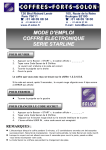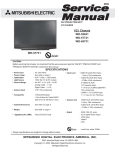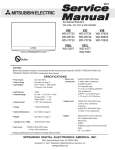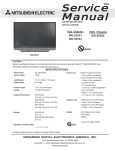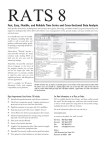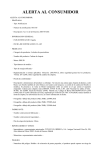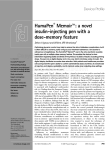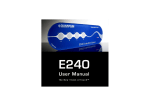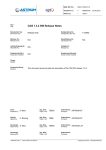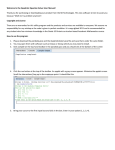Download MDQA User Manual v2.01 - Archives of Personal Papers ex libris
Transcript
Mishap Description Quality Analyzer An Event Description Quality Evaluation Toolkit MDQA User Manual What is the Mishap Description Quality Analyzer? The Mishap Description Quality Analyzer is a set of tools to help users evaluate the quality of descriptions of what happened in accident and other kinds of investigation reports. The toolkit consists of the procedures described in this Manual, a tutorial, supporting file templates, and an open source General Public License. You have to provide the report, label sheets, colored markers, and a work surface for arraying the labels. This Manual This Manual contains the procedures for evaluating the quality of reported descriptions of what happened during mishaps and other phenomena. After reading through this Manual the first time, please review the tutorial with the examples to help you build your evaluation skills. CONTENTS Part I. Report annotation tasks. 1. Familiarization task 2. Mark reported actions 3. Find inferred actions 4. Insert inferred actions Part II. Action documentation, organization, analysis and reporting. 1. Set up project files for processing 2. Enter marked actions in data bases 3. Prepare label file 4. Print out labels with actions 5. Organize, array and link labels on work surface 6. Analyze display 7. Report findings References © 2012 Ludwig Benner Jr. Page content is available free under the terms of a GNU General Public License, v3. View copyright terms at http://opensource.org/licenses/gpl-license before reproducing any content. If you use any material from this site, please reference this site as the source, and honor copyrights. For comments or assistance, contact: "luben" at this web site. MDQA Manual v2.01 Page 1 of 11 15-Jan-13 Mishap Description Quality Analyzer An Event Description Quality Evaluation Toolkit How do I use the Mishap Description Quality Analyzer? Start with a digitized or printed narrative report of an incident, accident, fire, spill, explosion or other occurrence, and your desire to know how “good” it is. First you look for and mark every thing that reportedly happened during the occurrence it describes. Then you record those actions into a word processor table (database) and prepare a label for each action. Next, you affix those labels onto a work surface in the sequence they occurred. Then you find and link all reported inputs to each reported action, to display the reported scenario. When that task is completed, you analyze your display to develop your evaluation of the description. Each task is described in this manual, for digitized or paper reports. Skim this manual, then build your skills with the tutorial exercises. Before you start a project… Supplies: Get a supply of 1” x 2.63” or equivalent label forms for the printed labels, and a work surface like a roll of butcher paper for arraying the labels and links you will create. Suggested highlight colors are #1 light green, #2 yellow and #3 red. File preparation: Use MS Word application. Create and name a new project folder on your computer with your new project name or ID. Copy the MDQA kit files to your project folder. Replace the EE in the file names with your project ID. Then load a digitized MS Word .doc/docx copy of the report file into that project folder. Evaluation goals Keep in mind you are trying to determine the quality of the reported description of what happened with the EA system. MDQA is not intended to satisfy any other report quality criteria. You do this by recasting the reported description text into specially formulated building blocks, organizing those building blocks in a certain way, and then looking for quality deficiencies. Evaluating Reported Description The evaluation process consists of two main parts: preparation of the report for processing, and processing the marked data in the report. MDQA Manual v2.01 Page 2 of 11 15-Jan-13 Mishap Description Quality Analyzer An Event Description Quality Evaluation Toolkit Part I. Report preparation tasks. This part covers the report preparation steps to identify and mark the data you will be using for your quality evaluation. Focus on isolating the actions contained in the report, which you will use for your quality evaluation. When completed, you will have a marked up document from which you can quickly enter the data to use for your quality analysis. Step 1. Read the report. Review the narrative section(s) in the report to get acquainted with what happened, the setting and the report contents. Try to visualize a “mental movie” of what happened as you read the report. Step 2. Identify and mark reported actions. During this step, you want to mark every reported event in the report. An event is an actor + an action. Use highlight color #1 to mark the text containing the reported name of every actor contained in the report. An actor is some person, object or energy that the report says did something during the occurrence. Next, highlight each action by each marked actor. An action is what the report says each marked actor did. The actor and action words are not necessarily contiguous in a report. 2. Frequently asked questions. i Q 1. What should I mark during this step? A: Mark all explicitly stated actions reported in the document. An action consists of a named person or object (actor) with words stating what the person or object did (action). Mark the name and words that describe what the actor did. The words should but may not always enable you to visualize the persons or objects and what they did. Q 2. Should I use a pen or pencil to mark a paper copy of the report? A. Highlighter markers are preferred on paper documents. If you are uncertain use pencil and mark the words, so you can erase your marks if you change your mind before highlighting them. Q 3. How do I handle pronouns? A: Highlight pronouns like he or she or it or they if followed by an act. You will MDQA Manual v2.01 Page 3 of 11 15-Jan-13 Mishap Description Quality Analyzer An Event Description Quality Evaluation Toolkit determine and assign one name during a later step. Q 4. How do I handle different names for the same actor? A: Mark all names in the report. The multiple names for the same person or object will get straightened out during later steps. Q 5 . How do I handle plural names like "the crowd" or "they?" A: Mark them, too. You will deal with them later. Q 6. How do I handle multiple actions by an actor? A: Depends. If two or more acts follow a named actor, and the acts are linked by words such as "and," "then" or "before," etc., highlight both actions if you are reasonably certain from the report that the same actor did both acts. "He raised..." "then proceeded.") Q 7. How do I handle two people doing the same thing? A: You may have two actions if connected with an “and”. Mark both actor names, and then highlight the action. In the tutorial example, see "Pilot and passengers exited.” If not connected, you may have a data conflict when report attributes an action to two different actors. Q 8. What if a person or object is named, and the report does not describe anything they did? A: You may have inferred actions. See inferred actions, Task 3 and 4. Q 9. What parts of a document should I mark up? A: All parts. Mark any actions reported in the document, because you never know where a writer will report an action. Often you will find acts for the first time in the conclusions or appendix sections, while in other reports they may be reported in the introduction, descriptions, analyses, cause or findings sections of reports. Read the whole document looking for acts by named people or objects, and mark what you find. Q 10. What should I do with actions I don't think are worth marking? A: Mark everything anyone or anything reportedly did. At this step of the description quality evaluation process, it is premature to make judgments about the validity, relevance, significance, or value of any of the acts described in the report. Those judgments can only be made when the acts can be placed in the context of other actions. When a report attributes the data to someone, as in "he stated" and "he claims" highlight these reported actions. Their importance or relevance cannot be assessed critically at this step. If in the Tutorial example the pilot said he thought the speed was 30 knots, and it turns out other reported data such as aircraft damage indicates it was 60 knots, this conflict might indicate a problem that should have been investigated. Was the difference due to a) a misunderstanding between the witness and investigator, b) the pilot's skill in judging speed, c) the pilot is misleading the investigator for reasons as yet unknown, d) instruments were giving false readings, etc.? Value can only be determined MDQA Manual v2.01 Page 4 of 11 15-Jan-13 Mishap Description Quality Analyzer An Event Description Quality Evaluation Toolkit when more is known about what happened. (During data entry, whoever "he" was would be shown as the source of the stated or claimed action.) Q 11. What should I do if the report describes what an object did NOT do? A: Do not mark it on the report. This information becomes part of your analysis task later. DID NOT in a report often reflects a conclusion that some action was expected (by the investigator) and did not happen without reporting the reasoning. Stick to what people or objects reportedly DID. During investigations, you may try to identify what should have happened, and what supported your expectation for each such action. Then, record that in a DID rather than DID NOT format. For example, if some procedure or rule or standard said the person or object was supposed to do something, use the procedure or rule or standard as the actor, and express the expected action as ""Rule called for x to do y at this time." If expectations played a role or were supposed to play a role and didn't, it is good practice to put the data into the actor/act format, or you will find yourself getting subjective about things like errors, failures, etc. Any actions that have no value in understanding or explaining what happened will be filtered out during subsequent steps. Step 3. Identify and mark words inferring actions. Your next task is to identify and mark WORDS in the report which indicate but do not fully described actions, or INFERRED actions. These words indicate something that happened, but don’t explicitly state the actor or action in the format you need. The challenge is to locate these inferred or masked - “hidden” - actions. Highlight these words or word sets so they are readily identifiable. 3. Frequently asked questions. Q 1. Why process inferred actions? A: The need for readers to infer the actions constitutes an undesirable quality attribute of the report’s description. However, it seems desirable to try to credit the report for the data, despite its format. Q 2. How can I recognize an inferred action? A: Look for specific clues, like: a. Passive voice clue. When you see the word "was" or "were" look for an underlying action. Example: "wing was deformed" infers that someone or something deformed the wing. b. Changed state clue. When you observe words indicating a change of state from a prior state, look for action(s) that produced the new state. Examples: tire skid mark on runway 18 infers that a tire or runway did something to produce the skid mark on the MDQA Manual v2.01 Page 5 of 11 15-Jan-13 Mishap Description Quality Analyzer An Event Description Quality Evaluation Toolkit runway 18. The description of the skid mark infers that the aircraft or tire did something else before they came to rest in the dirt pile. (Selecting words to describe what happened can be very challenging to investigators so they often use "cover up statements" like was corroded, etc. c. Mental action clue. Some word combinations infer that someone or something was involved in a mental action like a decision, choice or observation. For example: "His estimated speed..." infers that someone estimated the aircraft speed at some point in time but report doesn't say who or when. Q 3. How should I mark words inferring actions? A: In computer and paper files, highlight the words with color #2 so they are readily discernable.. Q 4. What happens if I mark words that should not be marked? A: Nothing serious. They will be treated during subsequent steps. Q 5. What happens if I miss words that I should have marked? A: Err on the side of marking too many rather than too few. When you do subsequent tasks, you will be guided to look for words that should have been marked, and if they are there, you’ll get a second chance to mark them. Step 4. Format inferred actions. This task is to format inferred action words into standard BB form, by converting each set of inferred action words into the actor/action format. For digitized files, For paper files, insert all the inferred action BBs number the highlighted inferred into the report within parentheses action words consecutively, and after the highlighted inferred on a separate paper list the words. Use a contrasting color inferred action BB for each (#3 light red) for these analystnumber. Highlight analystformatted entries. formatted entries with color 3 MDQA Manual v2.01 Page 6 of 11 15-Jan-13 Mishap Description Quality Analyzer An Event Description Quality Evaluation Toolkit 4. Frequently asked questions. Q 1. How should I convert and format inferred actions? A: Convert the reported statement into the name of the person or object that acted, if it can be identified, and what they did, if reported. Format the inferred action in the actor/action format. Q 2. What if I can't identify the actor or act from the words or report? A: Use a “?” placeholder in lieu of the actor name or action to show that you do not know the name or what the actor did, or both. Q 3. How will I show the inferred actions? A: Insert the inferred actions in parentheses, using “?” when the name of the actor or action is not identifiable, or when more information about either should be shown. Q 4. Should I just skip over the obviously irrelevant actions? A: NO, not at this stage. You are not ready to jump to conclusions until you can see how the inferred action might point to missing data that would help define what happened, or suggest aspects of the process not yet considered, or other discoveries. You will note reported irrelevant actions during your analysis stage. Q 5. Should I guess at the uncertainties indicated by a “?” to complete an action? A: NO! NO! NO! It’s tempting, but remember your task is to assess the quality of what is reported, without interjecting your new data, even if it is "obvious" to you. MDQA Manual v2.01 Page 7 of 11 15-Jan-13 Mishap Description Quality Analyzer An Event Description Quality Evaluation Toolkit Part II. Action documentation, organization, analysis and reporting. Part II tasks transfer the marked data from the reports, and print the data on labels which are then organized, analyzed and tested to show the reported scenario. Hint: The templates can also be used to conveniently capture, organize, display, analyze and evaluate data as acquired during investigations. Task 1. Set up folders/directories and files for your project a. Open your renamed EE-Keys.doc, EE-BBdb_Templatre.doc, EEGlossary.doc and EE-Label template.doc files in your new project folder/directory. The EE-Label template.doc file will produce 1”x 23/4” labels. b. Arrange the windows for each file on you screen so all the scroll bars are visible. Task 2. Enter actors and actions in the BBdb file. a. Enter marked actors and actions from the report. a. Hint: split screen or 2 screens to display BBdb and marked up report makes this step easier. b. After all the data are entered in the renamed BBdb file, check marked actions against entered BBs, to verify entries before proceeding. c. (Optional) Add any new actors or actions to the glossary database if you will analyze more than one report; this glossary will help you keep actor names consistent throughout all reports. d. If your MS Word preferences are not set to save your file at frequent intervals, save the BBdb manually every 5-6 records, and the glossary file with every few additions. Make this a habit whenever you enter data into these files. Task 3. Create the label file. a. Save all open files before proceeding. Follow MSWord procedures for producing BB labels with your EE-Label template and your BBdb file data source. Print actor row labels with the EE-Glossary.doc MDQA Manual v2.01 Page 8 of 11 15-Jan-13 Mishap Description Quality Analyzer An Event Description Quality Evaluation Toolkit b. Use of Avery 5160 or 5190 labels or equivalent is suggested. Show any fields you desire on the labels, but include at least the actor, action source and record number on each. Task 4. Print labels. a. To print labels, print the EE-Label template file or the label document file from the document you created with the label maker. b. Save the new label file to your new folder/directory. c. Review the label document for formatting, spelling and errors one final time before printing. Edit and reprint if necessary. NOTE: During investigations you will be saving numerous label files as records are added or changed. d. Print the new file with the merged labels on Avery 5160 (or equivalent) address label stock. e. Close your files when finished, making sure your folder/directory contains your marked up report file, your Summary Quality Evaluation Report file, Keys.doc, BBdb.doc, Sourcedb.doc, EEGlossary.doc and the label file you created for printing the labels. Task 5. Organize labels on a work surface. Paste the labels in sequence, and mark links to show input-output relationships on your work surface, to create an MES Time/Actor matrix, in accordance with guidance provided by Multilinear Events Sequencing (MES) Guide 2. The Guides can be found online and viewed or downloaded at http://www.ludwigbenner.org/arch6.html Optional: you may wish to cut the labels while the backing is still in place so you can shift them around on the work surface until you are satisfied you have them sequenced correctly. Then you can remove the backing and paste them in place before you start linking them. Task 6. Quality assurance analysis. Ideally, a report should enable the reader to make a “mental movie” of what happened, and understand why it happened. That’s the basic description quality test – a mental movie logically sequenced, with no missing or fuzzy frames. Examples of deficiencies in reported descriptions you might find and address in your quality analysis and report are: a. Ambiguities (pronouns, passive voice, abstract words, factors, plural names, generalizations, etc.) MDQA Manual v2.01 Page 9 of 11 15-Jan-13 Mishap Description Quality Analyzer An Event Description Quality Evaluation Toolkit b. Incomplete data (“?” remain in BBs) c. Incomplete description (unexplained gaps in flow of linked BBs) d. Unsubstantiated conclusions (did nots, failed to, neglected, less than adequate, etc. - judgmental statements or logic errors) e. Extraneous data (unlinked BBs may indicate irrelevant data) f. Conflicting data (report attributes two different actors to same act, or different names to an actor, or reports two actions that are incompatible physically, temporally or spatially.) g. Spurious or misleading data (statements or assertions that may reflect attempted misdirection or obfuscation in a report, indicated by reported actions that don’t fit anywhere on your matrix.) For convenience, make notes about deficiencies on the work surface. Every remaining “?” or discontinuity or ambiguity or form of “did not” or unlinked BBs in the final display indicates a potential quality issue with the report. Task 7. Report findings. Prepare a summary of any quality shortcomings found in the reported description by your quality assurance analysis of the final work surface display. NOTE: Descriptions of what happened are not the place to vary or use fancy language just to make the report esthetically more pleasing or show off literary skills. Watch for ambiguities in the fancy words. Do not embellish what was reported with your own new actions; reformatting of inferred entries extracts partially reported action. If required, in a separate document suggest new or additional data that would help clarify what happened or help explain it better. MDQA Manual v2.01 Page 10 of 11 15-Jan-13 Mishap Description Quality Analyzer An Event Description Quality Evaluation Toolkit i References Benner, L. and Rimson I.J., QUALITY MANAGEMENT FOR ACCIDENT INVESTIGATIONS, ISASI forum, October 1991 (24:3) and March 1992 (25:2), http://www.iprr.org/lib/QMA_P1.html Benner, L., Multilinear Events Sequencing (MES) Guide 1. TASK GUIDANCE FOR DOCUMENTING INVESTIGATOR’S OBSERVATIONS (EB Guide), Starline Software Ltd, 2005 http://www.ludwigbenner.org/manuals/MESGuide01.pdf Benner, L., Multilinear Events Sequencing (MES) Guide 2. BUILDING MES-BASED MATRIXES (MATRIX Guide), Starline Software Ltd, 2005, http://www.ludwigbenner.org/manuals/MESGuide02.pdf MDQA Manual v2.01 Page 11 of 11 15-Jan-13











